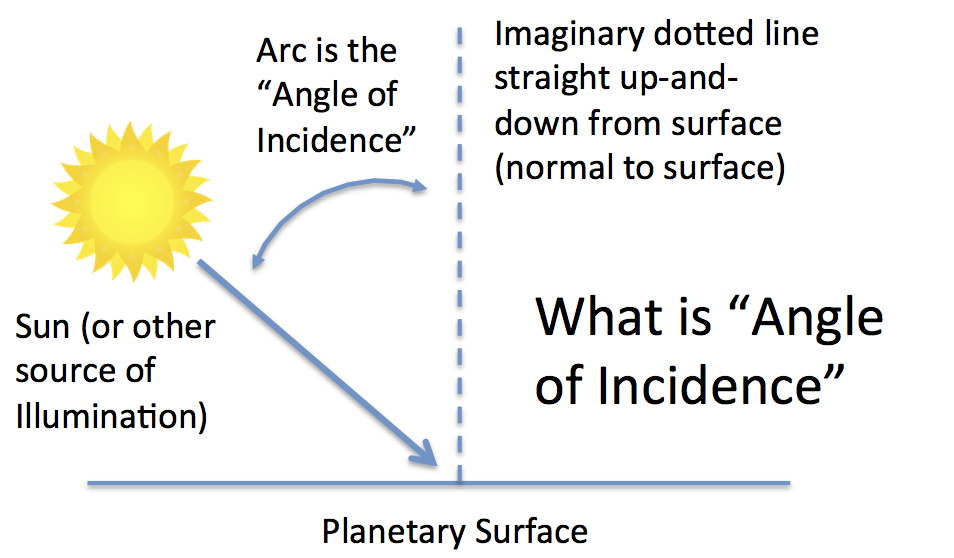In the last post in this series, we talked about “incidence angle” and hearkened back to a couple of CosmoQuest posts on the topic including the Moon Mappers tutorial section on lighting effects , and a post about “Illumination and Optical Illusions.” In this post, we are going to take a specific look at why incidence angle matters for mapping craters. In particular, we are going to highlight how our science team is using your work to advance scientific investigations into the subject! (And in the next posts of this series, Posts 10 and 11, you get to use your knowledge and your experience measuring craters to solve crater mapping mysteries!)
To start here’s a reminder from the last post about the definition of incidence angle – it lets us know the angle at which our target surface is being lit up. Is our lighting source overhead (low angle) or near the horizon (high angle)?

Incidence Angle: This diagram shows how scientists define “incidence angle” or “angle of incidence.” When the Sun is nearly overhead, the arc shown in the diagram is small. When the Sun is near the horizon, the arc is big. That big arc is a “high” angle of incidence. Diagram credit, Jennifer Grier
This effect is very important for impact crater studies. As you can see from the next image, the same general area on the Moon can look very different at two different angles of incidence. Look at each image carefully. You can see that small craters are easily identifiable at high incidence angle (left image). You can count lots of them, and you can see the rims easily if you wanted to measure their size. However, ejecta from these craters can be hard to find. At low incidence (right image), dark-and-light (albedo) differences are easily identifiable. For example, you can see crater rays and ejecta in this image. However the identification of craters and their rims becomes more challenging.
Which image would you want to use to do crater studies? It depends on what you are studying. If you want accurate crater counts, it might be best to use the image on the left. But if you want to find young craters with fresh ejecta, you probably need the image on the right. (As a lunar crater scientist, I use both whenever possible) 🙂

Side by side images: LROC image examples of high versus low incidence angle. Images are of nearby (not identical) regions of the Moon. Images are from NASA/LROC, and appear in Grier et al., submitted LPSC 2018.
Using the data you have generated here at CosmoQuest, we are studying how citizen scientists see and count craters. Previous work with experts suggests that the incidence angle effect is very important – even experts do better, more accurate counts on images like the one on the left. We want to know, is that scenario supported by citizen counts here at CosmoQuest? Why or why not? How can we make accurate counting as easy as possible for both experts and the general public? What do we do when we just don’t have a nice high angle image, but have to do with counting on low incidence angle images? Can we create a correction factor? These are the kinds of questions we are asking and that you are helping us answer. Our team will be presenting preliminary results on these questions at the Lunar and Planetary Science Conference in Houston this year, so stay tuned for more!




 Join the Crew!
Join the Crew!
 Escape Velocity Space News
Escape Velocity Space News
0 Comments